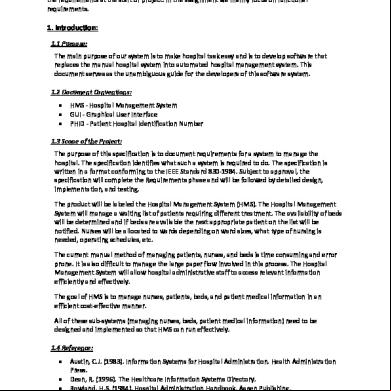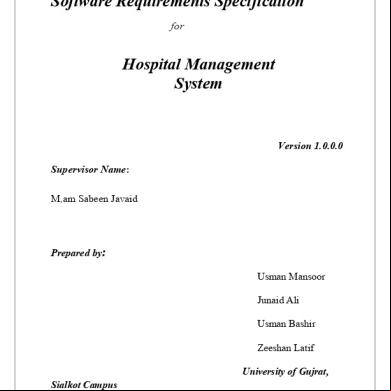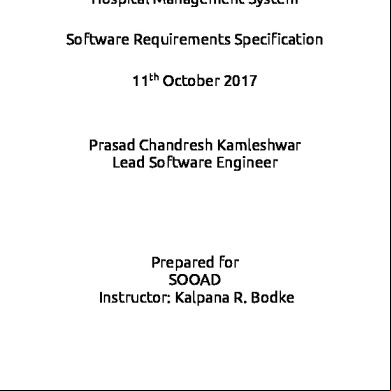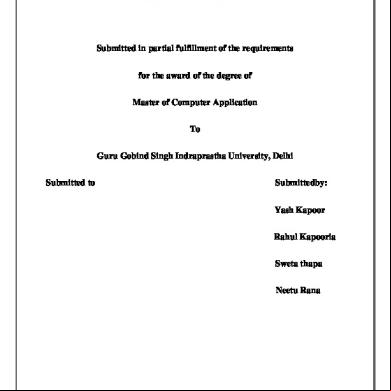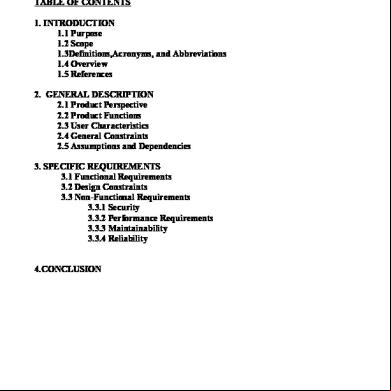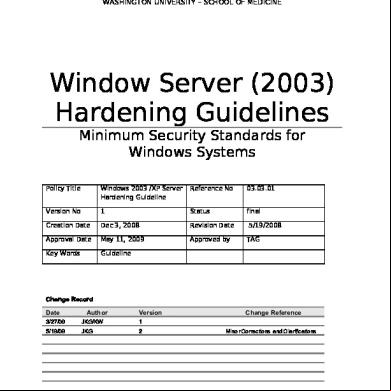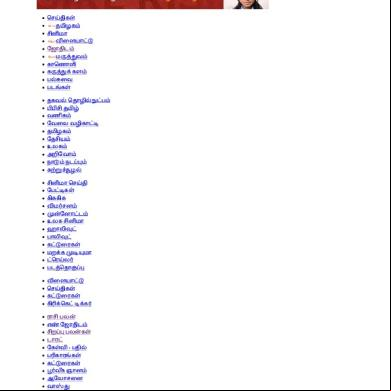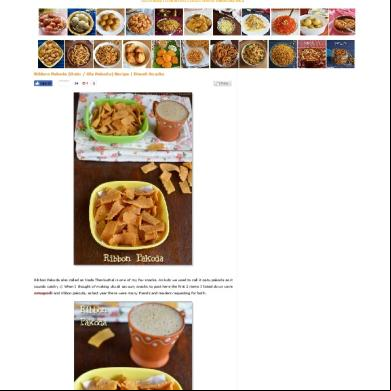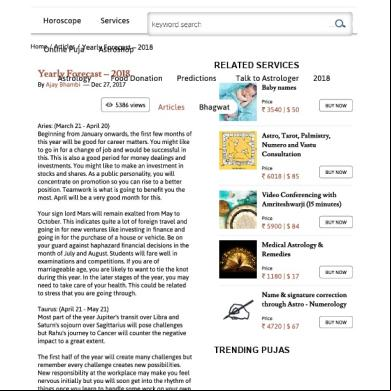Srs For Hospital Management System 5c5cp
This document was ed by and they confirmed that they have the permission to share it. If you are author or own the copyright of this book, please report to us by using this report form. Report 3b7i
Overview 3e4r5l
& View Srs For Hospital Management System as PDF for free.
More details w3441
- Words: 2,590
- Pages: 15
c cc
! Initial draft created for early distribution and review
"# $%
Draft
Shao Jingqiu, Chad
Revision1
Cyprian, Li, Jingqiu
Revision of draft and adding of necessary 22-October 2002 omissions
Revision 2
Cyprian, Li, Jingqiu, Flip, Chad
Final revision
16-Oct-2002
23- October-2001
&c##" This document is a Software Requirements Specification (SRS) for the Hospital Patient Management System (HPMS). It describes the functions, goals and tasks that the system can perform. Software Team Development Inc. (STD) will use this document to describe the scope of the project and to plan for the system¶s design and eventual implementation. This document forms the basis for the contract between the hospital and Software Team Development Inc. (STD). The document lists the following features as the high-level requirements that the Hospital Patient Management System will satisfy: ork Scheduling ± asg nurses to doctors and doctors to patients |dmissions - |dmitting patients, asg the patients to appropriate wards Patient Care - Monitoring patients while they are in the hospital Surgery Management - Planning and organizing the work that surgeons and nurses perform in the operating rooms R? ard Management - Planning and coordinating the management of wards and rooms R? aiting list: Monitoring to see if there are any patients waiting for available beds, asg them to doctors and beds once these become available R? R? R? R?
The document also presents a number of requirements that can be classified into two categories: functional and non-functional requirements. Non-functional requirements can be used to improve the functioning of the computer system, but not the management of the hospital as a whole. For these requirements, Software Team Development recommends that the Hospital management identify a set of experts from their computer department and their legal department to formally accept the requirements. The primary areas of concern are performance, security and interface. Functional requirements, on the other hand, are requirements directly related to the hospital management. Software Team Development Inc. (STD) also recommends that the hospital management identify a set of experts in the different domains to examine and formally accept these requirements.
e would be grateful if you accept this document as the beginning of the process for approving the requirements and launching the design phase of the project. If you have any questions about this document please Chad La Fournie at (403) 210 7545 between 9 a. m. and 4 p.m. on weekdays. Your prompt response will be highly appreciated.
"$ """'#c# c!(")#c !" *+
%
*+*
The purpose of this document is to describe all the requirements for the Hospital Patient Management System (HPMS). The intended audience includes all stakeholders in the potential system. These include, but are not necessarily limited to, the following: istrative staff, doctors, nurses, surgeons and developers. Developers should consult this document and its revisions as the only source of requirements for the project. They should not consider any requirements statements, written or verbal as valid until they appear in this document or its revision. The hospital management and its team should use this document and its revisions as the primary means to communicate confirmed requirements to the development team. The development team expects many face-to-face conversations that will undoubtedly be about requirements and ideas for requirements. Please note that only the requirements that appear in this document or a future revision, however, will be used to define the scope of the system. *+,
c
The proposed software product is the Hospital Patient Management System (HPMS). The system will be used to allocate beds to patients on a priority basis, and to assign doctors to patients in designated wards as need arises. Doctors will also use the system to keep track of the patients assigned to them. Nurses who are in direct with the patients
will use the system to keep track of available beds, the patients in the different wards, and the types of medication required for each patient. The current system in use is a paperbased system. It is too slow and cannot provide updated lists of patients within a reasonable timeframe. Doctors must make rounds to pick up patients¶ treatment cards in order to know whether they have cases to treat or not. The intentions of the system are to reduce over-time pay and increase the number of patients that can be treated accurately. Requirements statements in this document are both functional and non-functional.
*+-
!.#."%//"
c
Hospital Patient Management System
Personal Health Number on health card
an of patients
""/"
collection of information in a structured form
0%1"!!
istrative staff that work at reception desk
2'
a identification number to enter the system
"(%
a word that enables one to gain ission into the system
/0/"%"
$"
an application that runs on the Internet
%(,333
an operating system produced by Microsoft Corporation that is Used to operate the computer using a graphical interface.
c2
a query language to interrogate the system
Patient Identification number
4
Graphical Interface
ccSoftware Requirements Speficification
*+5
!
No formal documents have been referenced in this document. *+6
(
This Software Requirements Specification (SRS) is the requirements work product that formally specifies Hospital Patient Management System (HPMS). It includes the results of both business analysis and systems analysis efforts. Various techniques were used to elicit the requirements and we have identified your needs, analyzed and refined them. The objective of this document therefore is to formally describe the system¶s high level requirements including functional requirements, non-functional requirements and business rules and constraints. The detail structure of this document is organized as follows: Section 2 of this document provides an overview of the business domain that the proposed Hospital Patient Management System (HPMS) will . These include a general description of the product, characteristics, general constraints, and any assumptions for this system. This model demonstrates the development team's understanding of the business domain and serves to maximize the team's ability to build a system that truly does the business. Section 3 presents the detail requirements, which comprise the domain model. Picture 1 shows an overview of the Hospital Patient Management System and the relationships between requirements. ,+
4"$
,+*
%
This Hospital Patient Management System is a self-contained system that manages activities of the hospital as bed assignment, operations scheduling, personnel management and istrative issues. Various stakeholders are involved in the hospital system. | general picture of the system and the relationship between various stakeholders in the hospital is shown in Picture 2.
,+, %
The system functions can be described as follows:
'"7 hen a patient is itted, the front-desk staff checks to see if the patient is already ed with the hospital. If he is, his/her Personal Health Number (PHN) is entered into the computer. Otherwise a new Personal Health Number is given to this patient. The patient¶s information such as date of birth, address and telephone number is also entered into computer system.
$"7 The patient goes to consultation-desk to explain his/her condition so that the consulting nurse can determine what kind of ward and bed should be assigned to him/her. There are two possible circumstances: a) If there is a bed then the patient will be sent to the bed to wait for the doctor to come. b)
If there is no bed, the patient is put on a waiting list until a bed becomes available.
"1. If a patient checks out, the istrative staff shall delete his PHN from the system and the just evacuated bed is included in available-beds list. 4": The system generates reportson the following information: patients, bed availability and staff schedules after every six hours. It prints out all the information on who has used which bed, when and the doctor that is taking care of a given patient as well as expected medical expenses.
,+- "" The system will be used in the hospital. The s, doctors, nurses and front-desk staff will be the main s. Given the condition that not all the s are computer-literate. Some s may have to be trained on using the system. The system is also designed to be -friendly. It uses a Graphical Interface (GUI).
0%1"!!7 They all have general reception and secretarial duties. Every staff has some basic computer training. They are responsible for patient¶s check-in or notification of appropriate people (e.g. notify or nurse when an event occurs). %#"7 They all have post-secondary education relating to general business istration practices. Every has basic computer training. They are responsible for all of the scheduling and updating day/night employee shifts. |dministrators in the wards are responsible for asg doctors and nurses to patients. 7 |ll nurses have post-secondary education in nursing. Some nurses are computer literate. Consulting nurses to whom patients give short descriptions of their conditions are also responsible for asg patients to appropriate wards if the beds are available, otherwise putting patients on the waiting list. Nurses in wards will use the HPMS to check their patient list. 7 |ll doctors have a medical degree. Some have further specialized training and are computer literate. Doctors will use the HPMS to check their patient¶s list.
,+54"$" R The system must be delivered by January 1st 2003. R The existing Telecommunication infrastructure is based on IEEE100802.3 standards and the system must conform to this standard using category 5 cables for networking R The system must be -friendly
,+6# "% % R
It is assumed that one hundred IBM compatible computers will be available before the system is installed and tested.
R
It is assumed that the Hospital will have enough trained staff to take care of the system
-+c !)# -+*"$)# '" cc33*
%% " The HPMS shall allow front-desk staff to add new patients to the system.
cc33,' The HPMS shall allow front-desk staff to give each patient a ID and add it to the patient¶s record. This ID shall be used by the patient throughout his/her stay in hospital.
$"
cc33-
'"% The consulting nurse shall use HPMS to assign the patient to an appropriate ward.
cc335'"'2 The consulting nurse shall use HPMS to assign Patient to a waiting list if no bed is available. %"$#"#""'#
cc336
' The istrative staff in the ward shall use HPMS to assign a doctor to a given patient.
cc338
' The istration staff in the ward shall use HPMS to assign a nurse to a given patient.
cc339
!# The HPMS shall inform doctors of new patients.
cc33:
!# The HPMS shall inform nurses of new patients.
cc33;
#'" In an emergency case, the istrative staff shall use HPMS to assign an emergency room, doctors and nurses to the patient immediately.
cc3*3
c'" In a surgery case, the istrative staff shall use HPMS to assign asurgery room, surgeon and nurses to the patient.
cc3**
4" #"$ The HPMS shall generate the patient¶s situation record every two hours for normal patients.
cc3*,
4" c The HPMS shall generate patient¶s situation record every half hour for severe patients.
cc3*-
% % The whole treatment procedure for the patient shall be recorded by the system.
cc3*5
!# " The HPMS shall automatically inform the patients who are on the bed waiting list of available beds whenever they become available.
1
cc3*6
cc3*8
$ " The istrative staff in the ward shall be allowed to delete the ID of the patient from the system when the patient checks out. %%/%0""$"/$$ The istrative staff in the ward shall be allowed to put the beds just evacuated in beds-available list.
4" cc3*9
"!#" Every six hours the HPMS shall generate reports on patients about the following information: patient¶s PHN, patient¶s name, ward name, bed number and the doctor¶s name.
cc3*:
<%""$"/$ Every six hours the HPMS shall generate reports on bed availability about the following information: ward name, bed number, occupied/unoccupied
cc3*;
c"!!c%$ Every six hours the HPMS shall generate reports on staff schedule about the following information: staff ID, staff name, staff type, duty shift.
""/" cc3,3
cc3,*
""%" !#" Each patient shall have the following mandatory information: first name, last name, phone number, personal health number, address, postal code, city, country, patient identification number. %" " !#" The HPMS shall allow the to update any of the patient¶s information as described in SRS020
cc3,,c"! " The HPMS shall allow the to search for patient¶s information by last name or PHN or patient ID. cc3,-
c"!!"%" !#" Each staff in hospital shall have the following mandatory information: identification number, first name, last name, phone number, address, postal code, city, country, employee type, duty schedule.
cc3,5
%"c"!! !#" The HPMS shall allow the to update any of the staff¶s information as described in SRS023.
cc3,6
# $ !#" The HPMS shall allow the to search for employee information by last name, or ID number.
cc3,8
"% The ward is categorized into four types: Maternity, Surgical, Cancer and Cardiac.
cc3,9"% !#" Each ward in HPMS shall include the following mandatory information: ward name, ward number, list of rooms in ward. cc3,:
# !#" Each room in HPMS shall include the following mandatory information: room number, list of beds in room, full/not full.
cc3,;
<% !#" Each bed in HPMS shall include the following information: bed number, occupied/unoccupied, patient PHN.
cc3-3
"% c" The HPMS shall allow s to search the ward, room, and bed directly by ward number, room number and bed number respectively, or by hierarchal hyperlinks from ward to bed.
-+,'" cc3-*
""/" The system shall use the MySQL Database, which is open source and free.
cc3-,
"'c# The Development environment shall be indows 2000.
cc3--
/0<"% The system shall be a eb-based application.
-+- 0"$)# -+-+*c cc3-5
" %!" The system requires the patient to identify himself /herself using PHN
cc3-6
2' |ny who uses the system shall have a Logon ID and .
cc3-8
%!" |ny modification (insert, delete, update) for the Database shall be synchronized and done only by the in the ward.
cc3-9
# $" The system must comply with the Regional Health |uthority Regulations concerning privacy, section 703.2RH|/2000/v78
cc3-:
1"!!' Front Desk staff shall be able to view all information in HPMS, add new patients to HPMS but shall not be able to modify any information in it.
cc3-;
%#"'' |dministrators shall be able to view and modify all information in
HPMS cc353
=' Nurses shall only be able to view all information in HPMS.
cc35*
' Doctors shall only be able to view all information in HPMS
-+-+, !#")# cc35,
# The system shall give responses in 1 second after checking the patient¶s information. cc35-
" " The System must 1000 people at a time.
cc355
0!" The -interface screen shall respond within 5 seconds.
cc356
!# The systems must conform to the Microsoft |ccessibility
guidelines
-+-+-"""/$
cc358
cc359
<"1 The system shall provide the capability to back-up the Data The system shall keep a log of all the errors.
-+-+5$"/$ cc35:
>
"$"/$ The system shall be available all the time.
*7$" /( "$ """'#c#
Picture 2 Overview of Hospital Patient Management System
?
! Initial draft created for early distribution and review
"# $%
Draft
Shao Jingqiu, Chad
Revision1
Cyprian, Li, Jingqiu
Revision of draft and adding of necessary 22-October 2002 omissions
Revision 2
Cyprian, Li, Jingqiu, Flip, Chad
Final revision
16-Oct-2002
23- October-2001
&c##" This document is a Software Requirements Specification (SRS) for the Hospital Patient Management System (HPMS). It describes the functions, goals and tasks that the system can perform. Software Team Development Inc. (STD) will use this document to describe the scope of the project and to plan for the system¶s design and eventual implementation. This document forms the basis for the contract between the hospital and Software Team Development Inc. (STD). The document lists the following features as the high-level requirements that the Hospital Patient Management System will satisfy: ork Scheduling ± asg nurses to doctors and doctors to patients |dmissions - |dmitting patients, asg the patients to appropriate wards Patient Care - Monitoring patients while they are in the hospital Surgery Management - Planning and organizing the work that surgeons and nurses perform in the operating rooms R? ard Management - Planning and coordinating the management of wards and rooms R? aiting list: Monitoring to see if there are any patients waiting for available beds, asg them to doctors and beds once these become available R? R? R? R?
The document also presents a number of requirements that can be classified into two categories: functional and non-functional requirements. Non-functional requirements can be used to improve the functioning of the computer system, but not the management of the hospital as a whole. For these requirements, Software Team Development recommends that the Hospital management identify a set of experts from their computer department and their legal department to formally accept the requirements. The primary areas of concern are performance, security and interface. Functional requirements, on the other hand, are requirements directly related to the hospital management. Software Team Development Inc. (STD) also recommends that the hospital management identify a set of experts in the different domains to examine and formally accept these requirements.
e would be grateful if you accept this document as the beginning of the process for approving the requirements and launching the design phase of the project. If you have any questions about this document please Chad La Fournie at (403) 210 7545 between 9 a. m. and 4 p.m. on weekdays. Your prompt response will be highly appreciated.
"$ """'#c# c!(")#c !" *+
%
*+*
The purpose of this document is to describe all the requirements for the Hospital Patient Management System (HPMS). The intended audience includes all stakeholders in the potential system. These include, but are not necessarily limited to, the following: istrative staff, doctors, nurses, surgeons and developers. Developers should consult this document and its revisions as the only source of requirements for the project. They should not consider any requirements statements, written or verbal as valid until they appear in this document or its revision. The hospital management and its team should use this document and its revisions as the primary means to communicate confirmed requirements to the development team. The development team expects many face-to-face conversations that will undoubtedly be about requirements and ideas for requirements. Please note that only the requirements that appear in this document or a future revision, however, will be used to define the scope of the system. *+,
c
The proposed software product is the Hospital Patient Management System (HPMS). The system will be used to allocate beds to patients on a priority basis, and to assign doctors to patients in designated wards as need arises. Doctors will also use the system to keep track of the patients assigned to them. Nurses who are in direct with the patients
will use the system to keep track of available beds, the patients in the different wards, and the types of medication required for each patient. The current system in use is a paperbased system. It is too slow and cannot provide updated lists of patients within a reasonable timeframe. Doctors must make rounds to pick up patients¶ treatment cards in order to know whether they have cases to treat or not. The intentions of the system are to reduce over-time pay and increase the number of patients that can be treated accurately. Requirements statements in this document are both functional and non-functional.
*+-
!.#."%//"
c
Hospital Patient Management System
Personal Health Number on health card
an of patients
""/"
collection of information in a structured form
0%1"!!
istrative staff that work at reception desk
2'
a identification number to enter the system
"(%
a word that enables one to gain ission into the system
/0/"%"
$"
an application that runs on the Internet
%(,333
an operating system produced by Microsoft Corporation that is Used to operate the computer using a graphical interface.
c2
a query language to interrogate the system
Patient Identification number
4
Graphical Interface
ccSoftware Requirements Speficification
*+5
!
No formal documents have been referenced in this document. *+6
(
This Software Requirements Specification (SRS) is the requirements work product that formally specifies Hospital Patient Management System (HPMS). It includes the results of both business analysis and systems analysis efforts. Various techniques were used to elicit the requirements and we have identified your needs, analyzed and refined them. The objective of this document therefore is to formally describe the system¶s high level requirements including functional requirements, non-functional requirements and business rules and constraints. The detail structure of this document is organized as follows: Section 2 of this document provides an overview of the business domain that the proposed Hospital Patient Management System (HPMS) will . These include a general description of the product, characteristics, general constraints, and any assumptions for this system. This model demonstrates the development team's understanding of the business domain and serves to maximize the team's ability to build a system that truly does the business. Section 3 presents the detail requirements, which comprise the domain model. Picture 1 shows an overview of the Hospital Patient Management System and the relationships between requirements. ,+
4"$
,+*
%
This Hospital Patient Management System is a self-contained system that manages activities of the hospital as bed assignment, operations scheduling, personnel management and istrative issues. Various stakeholders are involved in the hospital system. | general picture of the system and the relationship between various stakeholders in the hospital is shown in Picture 2.
,+, %
The system functions can be described as follows:
'"7 hen a patient is itted, the front-desk staff checks to see if the patient is already ed with the hospital. If he is, his/her Personal Health Number (PHN) is entered into the computer. Otherwise a new Personal Health Number is given to this patient. The patient¶s information such as date of birth, address and telephone number is also entered into computer system.
$"7 The patient goes to consultation-desk to explain his/her condition so that the consulting nurse can determine what kind of ward and bed should be assigned to him/her. There are two possible circumstances: a) If there is a bed then the patient will be sent to the bed to wait for the doctor to come. b)
If there is no bed, the patient is put on a waiting list until a bed becomes available.
"1. If a patient checks out, the istrative staff shall delete his PHN from the system and the just evacuated bed is included in available-beds list. 4": The system generates reportson the following information: patients, bed availability and staff schedules after every six hours. It prints out all the information on who has used which bed, when and the doctor that is taking care of a given patient as well as expected medical expenses.
,+- "" The system will be used in the hospital. The s, doctors, nurses and front-desk staff will be the main s. Given the condition that not all the s are computer-literate. Some s may have to be trained on using the system. The system is also designed to be -friendly. It uses a Graphical Interface (GUI).
0%1"!!7 They all have general reception and secretarial duties. Every staff has some basic computer training. They are responsible for patient¶s check-in or notification of appropriate people (e.g. notify or nurse when an event occurs). %#"7 They all have post-secondary education relating to general business istration practices. Every has basic computer training. They are responsible for all of the scheduling and updating day/night employee shifts. |dministrators in the wards are responsible for asg doctors and nurses to patients. 7 |ll nurses have post-secondary education in nursing. Some nurses are computer literate. Consulting nurses to whom patients give short descriptions of their conditions are also responsible for asg patients to appropriate wards if the beds are available, otherwise putting patients on the waiting list. Nurses in wards will use the HPMS to check their patient list. 7 |ll doctors have a medical degree. Some have further specialized training and are computer literate. Doctors will use the HPMS to check their patient¶s list.
,+54"$" R The system must be delivered by January 1st 2003. R The existing Telecommunication infrastructure is based on IEEE100802.3 standards and the system must conform to this standard using category 5 cables for networking R The system must be -friendly
,+6# "% % R
It is assumed that one hundred IBM compatible computers will be available before the system is installed and tested.
R
It is assumed that the Hospital will have enough trained staff to take care of the system
-+c !)# -+*"$)# '" cc33*
%% " The HPMS shall allow front-desk staff to add new patients to the system.
cc33,' The HPMS shall allow front-desk staff to give each patient a ID and add it to the patient¶s record. This ID shall be used by the patient throughout his/her stay in hospital.
$"
cc33-
'"% The consulting nurse shall use HPMS to assign the patient to an appropriate ward.
cc335'"'2 The consulting nurse shall use HPMS to assign Patient to a waiting list if no bed is available. %"$#"#""'#
cc336
' The istrative staff in the ward shall use HPMS to assign a doctor to a given patient.
cc338
' The istration staff in the ward shall use HPMS to assign a nurse to a given patient.
cc339
!# The HPMS shall inform doctors of new patients.
cc33:
!# The HPMS shall inform nurses of new patients.
cc33;
#'" In an emergency case, the istrative staff shall use HPMS to assign an emergency room, doctors and nurses to the patient immediately.
cc3*3
c'" In a surgery case, the istrative staff shall use HPMS to assign asurgery room, surgeon and nurses to the patient.
cc3**
4" #"$ The HPMS shall generate the patient¶s situation record every two hours for normal patients.
cc3*,
4" c The HPMS shall generate patient¶s situation record every half hour for severe patients.
cc3*-
% % The whole treatment procedure for the patient shall be recorded by the system.
cc3*5
!# " The HPMS shall automatically inform the patients who are on the bed waiting list of available beds whenever they become available.
1
cc3*6
cc3*8
$ " The istrative staff in the ward shall be allowed to delete the ID of the patient from the system when the patient checks out. %%/%0""$"/$$ The istrative staff in the ward shall be allowed to put the beds just evacuated in beds-available list.
4" cc3*9
"!#" Every six hours the HPMS shall generate reports on patients about the following information: patient¶s PHN, patient¶s name, ward name, bed number and the doctor¶s name.
cc3*:
<%""$"/$ Every six hours the HPMS shall generate reports on bed availability about the following information: ward name, bed number, occupied/unoccupied
cc3*;
c"!!c%$ Every six hours the HPMS shall generate reports on staff schedule about the following information: staff ID, staff name, staff type, duty shift.
""/" cc3,3
cc3,*
""%" !#" Each patient shall have the following mandatory information: first name, last name, phone number, personal health number, address, postal code, city, country, patient identification number. %" " !#" The HPMS shall allow the to update any of the patient¶s information as described in SRS020
cc3,,c"! " The HPMS shall allow the to search for patient¶s information by last name or PHN or patient ID. cc3,-
c"!!"%" !#" Each staff in hospital shall have the following mandatory information: identification number, first name, last name, phone number, address, postal code, city, country, employee type, duty schedule.
cc3,5
%"c"!! !#" The HPMS shall allow the to update any of the staff¶s information as described in SRS023.
cc3,6
# $ !#" The HPMS shall allow the to search for employee information by last name, or ID number.
cc3,8
"% The ward is categorized into four types: Maternity, Surgical, Cancer and Cardiac.
cc3,9"% !#" Each ward in HPMS shall include the following mandatory information: ward name, ward number, list of rooms in ward. cc3,:
# !#" Each room in HPMS shall include the following mandatory information: room number, list of beds in room, full/not full.
cc3,;
<% !#" Each bed in HPMS shall include the following information: bed number, occupied/unoccupied, patient PHN.
cc3-3
"% c" The HPMS shall allow s to search the ward, room, and bed directly by ward number, room number and bed number respectively, or by hierarchal hyperlinks from ward to bed.
-+,'" cc3-*
""/" The system shall use the MySQL Database, which is open source and free.
cc3-,
"'c# The Development environment shall be indows 2000.
cc3--
/0<"% The system shall be a eb-based application.
-+- 0"$)# -+-+*c cc3-5
" %!" The system requires the patient to identify himself /herself using PHN
cc3-6
2' |ny who uses the system shall have a Logon ID and .
cc3-8
%!" |ny modification (insert, delete, update) for the Database shall be synchronized and done only by the in the ward.
cc3-9
# $" The system must comply with the Regional Health |uthority Regulations concerning privacy, section 703.2RH|/2000/v78
cc3-:
1"!!' Front Desk staff shall be able to view all information in HPMS, add new patients to HPMS but shall not be able to modify any information in it.
cc3-;
%#"'' |dministrators shall be able to view and modify all information in
HPMS cc353
=' Nurses shall only be able to view all information in HPMS.
cc35*
' Doctors shall only be able to view all information in HPMS
-+-+, !#")# cc35,
# The system shall give responses in 1 second after checking the patient¶s information. cc35-
" " The System must 1000 people at a time.
cc355
0!" The -interface screen shall respond within 5 seconds.
cc356
!# The systems must conform to the Microsoft |ccessibility
guidelines
-+-+-"""/$
cc358
cc359
<"1 The system shall provide the capability to back-up the Data The system shall keep a log of all the errors.
-+-+5$"/$ cc35:
>
"$"/$ The system shall be available all the time.
*7$" /( "$ """'#c#
Picture 2 Overview of Hospital Patient Management System
?

